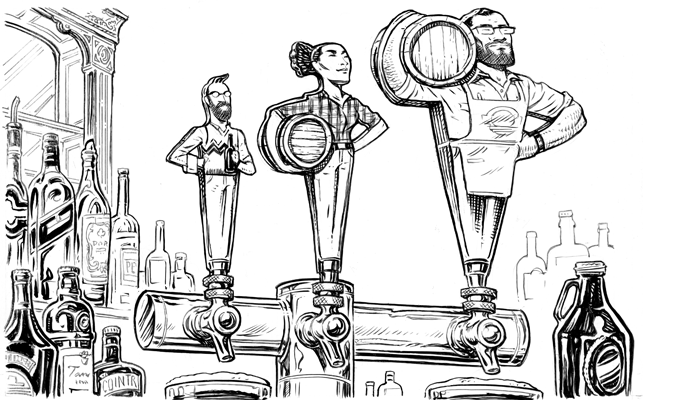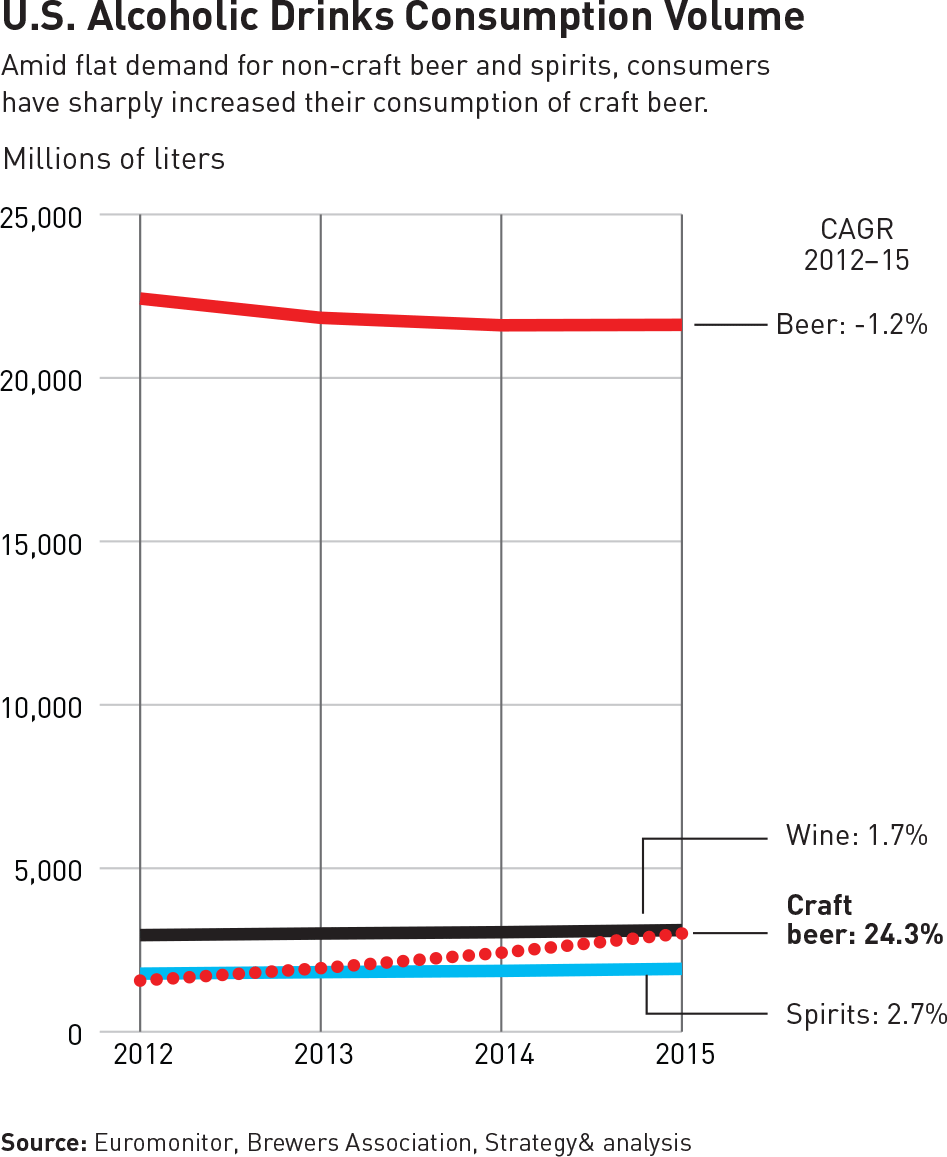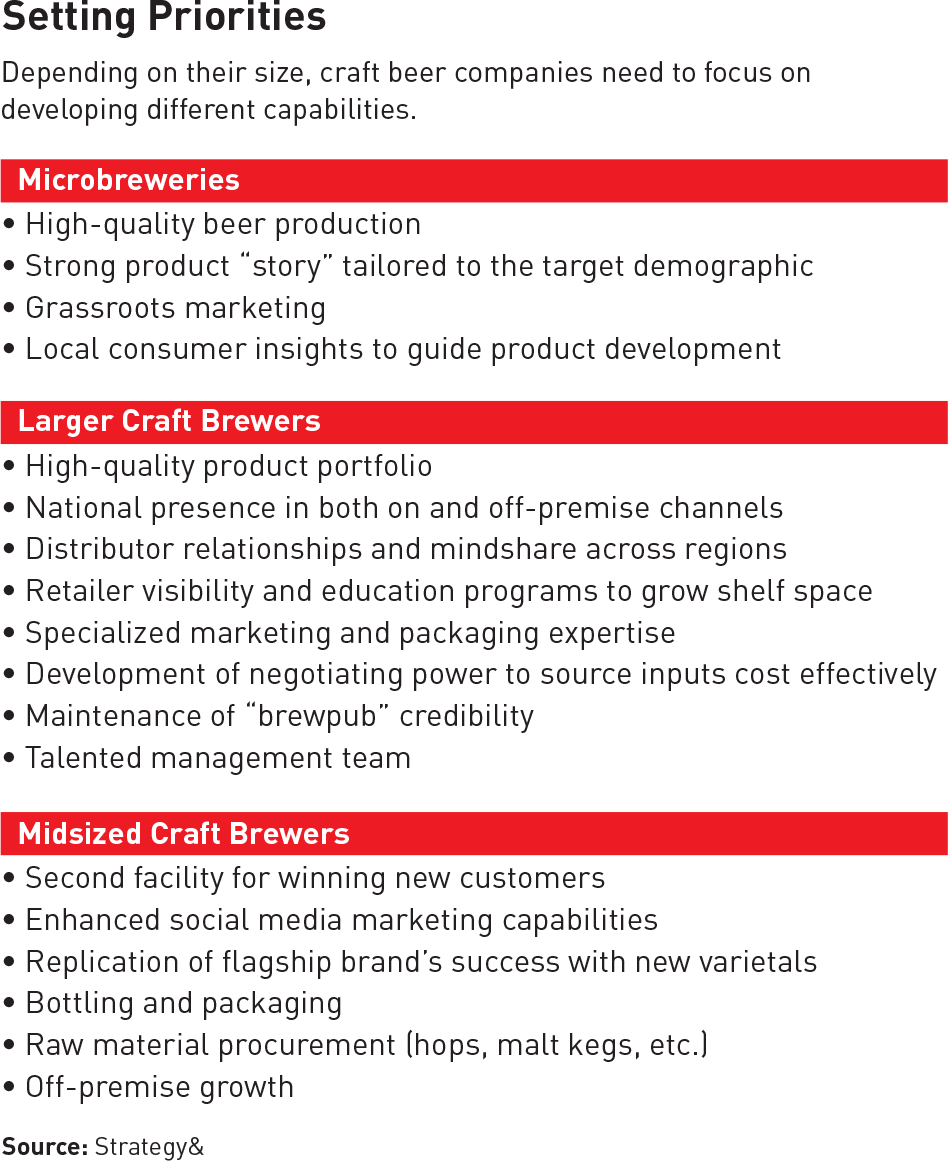Can Craft Beer Continue to Tap into Growth?
As the thriving sector matures, new growth strategies will be necessary.
A version of this article appeared in the Summer 2018 issue of strategy+business.
In late 2016, AB InBev, the beverage goliath best known for its iconic Budweiser brand, acquired Houston’s Karbach Brewing. The tiny brewer, founded in 2011, was named for the street where it operates. It produced just 55,000 barrels annually. The deal was one among dozens of similar acquisitions by strategic bidders and financial sponsors of craft brewers — independent, innovative (and often subscale) outfits that, for years, were a thriving segment of the U.S. beverage alcohol market.
Between 2012 and 2015, volumes for U.S. alcoholic drinks grew at an anemic compound annual growth rate (CAGR) of 1.1 percent, and non-craft beer’s share of drinks consumed fell from 78 to 73 percent. But in these years, craft brewers’ share of drinks consumed doubled, from 5 percent to 10 percent — representing a 24.3 percent CAGR in volume (see “U.S. Alcoholic Drinks Consumption Volume”).
Clearly, what began as a cottage industry run by a handful of enthusiasts just a few decades ago has come of age. In 1990, there were fewer than 300 craft breweries in the United States. But by 2016, the industry counted more than 5,000 breweries, with a combined US$24 billion in revenues; together, they held an impressive 22 percent share of the overall U.S. beer market.
The boom reshaped how the nation’s consumers perceived the segment. Within a generation, beer aficionados journeyed from settling for familiar light lagers at a subpremium price point (e.g., Coors Light) to identifying first with a beer’s origin (e.g., Colorado’s Fat Tire) or a particular style (e.g., IPA, stout, or pilsner) before considering the brand.
Brewers cemented their appeal by drawing beer drinkers into the breweries themselves, where customers could admire the steampunk beer-making technology and sample fresh brews in adjacent taprooms.
But signs of a slowdown are emerging. According to our analysis of data from the Brewers Association, in the first half of 2017, craft beer sales volumes rose just 5 percent, down from 8 percent in the first half of 2016 and from 16 percent in the first half of 2015. An increasing number of craft brewers are reporting sales declines for the first time, and some have been pushed into bankruptcy, such as San Francisco’s Magnolia Brewery.
Much of the flatness in the industry can be attributed to market saturation. There are only so many drinking occasions, and consumers are turning to a wider set of alcohol choices, including craft spirits. In addition, the continued proliferation of brands and styles has made it increasingly difficult to drive growth. Brewers are battling over retail shelf space and a finite number of tap handles at on-premises locations.
Positioning for a Maturing Market
Historically, several brewers made capacity investments assuming robust double-digit category growth. But as the growth rate of the overall category starts to slow, players that want to continue growing at double-digit rates will need to take share from others.
In our view, the market is developing into a barbell shape; smaller microbreweries and larger players on the peripheries occupy stronger positions than midsized players at the center.
Breweries of different sizes will have varying capability needs (see “Setting Priorities”) and sets of growth options that they can pursue.
Microbreweries. These businesses produce fewer than 15,000 barrels annually, and typically sell more than 75 percent of their output on-site. Examples include Portland’s Bissell Brothers and Chicago’s Spiteful Brewing.
Microbreweries enjoy high growth initially, but often struggle to maintain and build on that momentum. They trade on their deep local roots — for instance, leveraging local consumer insights to develop innovative, high-quality products and then marketing via grassroots channels. Their cachet accrues from their authenticity.
Looking ahead, these players will grow volumes by improving the ambience at their on-site brewpubs and taprooms and expanding their roster of clients to nearby towns.
However, the very attribute that makes them distinctive, their small size, can become a liability. The basic steps of scaling a business — such as opening a second taproom, installing a bottling line, or gaining retail distribution — may be beyond these firms’ managerial and financial capacity.
Moreover, a large proportion of microbrewery founders are aficionados whose primary focus is on brewing high-quality, authentic beer, as opposed to experienced business professionals who are keen to substantially grow their brand.
Larger craft brewers. These players produce from 80,000 to several million barrels annually, and include iconic names such as Sierra Nevada and Boston Beer.
This clutch of 50-odd breweries control about 90 percent of craft beer sales, and they have a broad set of options with which to go to market. AB InBev’s “High End” portfolio, for instance, has more than a dozen craft names. These brands enjoy national recognition and entrenched positions in key off-premises channels such as convenience stores and supermarkets.
For larger craft brewers, driving growth involves leveraging scale to deepen connections with suppliers, distributors, and customers. Like large players in other sectors, they deploy their greater negotiating leverage to source raw materials more cost-effectively, and ensure the stability of the supply of choice ingredients such as specialty hops. Additionally, they can generate greater mindshare with distributors and greater visibility with retailers.
The larger craft brewers have also been investing in specialized operations and packaging capabilities to deepen their cost advantages — for example, by installing canning lines that slash costs by up to one-third, or by sourcing glass bottles directly from large manufacturers.
Yet the factors that enable them to push these levers can also be a liability. Large craft brewers face real challenges in maintaining authenticity and credibility, traits that are appealing to millennials.
Midsized craft brewers. Players in this segment, which includes Chicago’s Revolution Brewing and Portland’s Allagash Brewing, produce between 15,000 and 80,000 barrels per year. In the current environment, they find themselves in a somewhat sticky spot.
Midsized brewers are penalized for not being smaller and more local, as they lack the perceived authenticity and network of local relationships that microbreweries have. At the same time, they lose out on the benefits of scale that accrue to larger competitors and find it difficult to grow in the retail channel. They face growth challenges — needing to expand regionally or nationally from their local or state focus — and also grapple with profitability pressures.
The data suggests that midsized brewers are being squeezed out by their smaller and larger competitors. According to our analysis of Brewers Association data, the average number of barrels produced by midsized craft breweries fell by about 4 percent between 2012 and 2016 — a period in which microbreweries and larger craft breweries posted modest gains, at 1.8 percent and 6.5 percent, respectively.
However, multiple growth pathways, both organic and inorganic, are available for midsized brewers. On the organic front, players can frame their strategy around their flagship brand and replicate its success by innovating with new varietals. These could be unique new styles (e.g., sour ale), seasonal flavors (e.g., winter cinnamon), or hybrids (e.g., barrel fermented) that offer customers adventurous new riffs on recognized brand names.
Other opportunities include developing additional breweries and taprooms to win new customers, investing in enhanced marketing and social media capabilities, or improving bottling and packaging capabilities (e.g., larger bottles). Chicago’s Band of Bohemia, for example, has distinguished itself as the world’s first Michelin-starred brewpub by investing in a quirky aesthetic and a high-quality food offering that is paired with its beer recipes.
Some players are looking farther afield at international expansion. For instance, India’s B9 Beverages, which makes the acclaimed Bira 91 brand, is now looking to make inroads in the U.S. market.
However, most midsized brewers will find that patiently building the capabilities to drive organic growth can be protracted and arduous. Organically building a differentiated brand name and product in an increasingly complex and saturated marketplace is a tall order, one that even larger craft brewers have found challenging. It’s also important to note that craft brewers may be poised to benefit from recent changes in U.S. tax law. The Craft Beverage Modernization and Tax Reform Act, which was part of the large tax reform package passed in December, proposes sharply reducing alcohol excise tax revenues by $4.2 billion over the next two years while reducing the same taxes on larger amounts by a smaller amount. However, because the bill doesn't clearly define the size/volume thresholds, larger craft brewers may end up benefitting disproportionately (vs. smaller brewers and preserving their advantage.
The Fizz in Deals
Looking ahead, deals — mergers, acquisitions, and sales — will become an appealing option for players in every segment of the market. The craft beer market has already seen some measure of consolidation, involving about 60 notable deals between 2012 and 2016. But we expect the pace of deal activity to grow, with high-quality assets making for prime targets.
Organically building a differentiated brand name and product in an increasingly complex and saturated marketplace is a tall order.
Scale has allowed larger brewers to be successful acquirers. In our analysis of post-acquisition cost structure changes, we have seen midsized craft brewers generate EBIT margin improvements in the range of 15 to 18 percent after being acquired by larger craft brewers.
Many will realize that they can use deals to build concentrated scale (e.g., broader scale across a particular region) and expand into the competitive off-premises market. Alternatively, players can explore the sale of their business. However, this option requires a careful evaluation of multiple dimensions: the partner in question (e.g., financial sponsor, larger competitor) and the structure of the transaction (e.g., part employee ownership, minority stake), as well as the multiples that similar businesses have commanded.
We are likely to see different M&A routes among craft brewers seeking to drive growth. An acquirer, or a seller, will have to settle on a path after considering its unique position and goals. Will an acquirer seek to integrate the new operation, or simply provide outside support? Will a founder continue to have a day-to-day role in the business after a sale? Where you stand on the approach to M&A will depend, in large part, on where you sit competitively. Possible routes are below.
1. Outright acquisitions. This approach is likely to be favored by larger players. When larger brewers purchase craft players outright — as in Constellation Brands’ $1 billion purchase of Ballast Point in 2015 — the transaction is clean and synergies are readily realized. But in these cases, retaining founders and executives may prove challenging.
2. Minority investments. The most attractive breweries are typically keener to sell minority stakes and retain their independence. That’s why minority investments can be a preferred route, especially when the founder’s continued involvement is paramount. Recent examples include TSG Consumer’s 23 percent stake in Scottish craft brewer BrewDog in 2017 and LNK Partners’ 15 percent interest in Dogfish Head Brewery in 2015. After taking minority stakes, acquirers often preserve the founder’s tried-and-tested processes, and provide outside support where needed, in areas such as procurement and marketing. Although this approach can protect the brand’s cachet and spirit, it will likely limit the extent of operational synergies that can be realized.
3. Path to control. Taking a minority stake that can lead to a majority stake is often the most balanced option that larger brewers can pursue. For instance, Heineken’s investment in Lagunitas offered flexible structuring scenarios, providing exposure to higher-growing businesses for the sellers, and locking in a valuation for the buyers. After making its initial 50 percent investment in 2015, Heineken was able to test the global waters for Lagunitas. It gradually expanded distribution of the craft beer before completing the buyout in 2017. By building scale and bringing new brands into a wider distribution network, path-to-control deals offer great potential for revenue synergies. However, they present limited room for integration synergies and can lead to conflicts of interest.
4. Rollups. When a larger company acquires several small brands, the sponsors can build a sizable national platform with attendant scale advantages. The holding company structure provides liquidity and organization. Examples include Fireman Capital’s CANarchy, a portfolio of five U.S. craft beer brands. However, assets of varying sizes can complicate the ownership structure as participants jockey to convey their worth to the larger entity and set the overall direction. Cultural fit can also pose problems between breweries, sponsors, and portfolio companies.
5. Employee stock ownership plans (ESOPs). In addition to these M&A routes, players seeking to remain independent may raise capital to propel growth. One popular — though highly challenging — route is for founders to generate liquidity and incentivize employees by selling equity to its workers. After selling 42 percent of its equity to workers in 2000, New Belgium Brewing became 100 percent employee-owned in 2013. ESOPs can help founders maintain their distinct culture and preserve control in the short term. But they are a complicated M&A tool that presents challenges in execution, ownership, and financial management.
When markets evolve from a high-growth phase into a mature phase, the transition naturally creates some upheaval. Brewery executives will be forced to react to changes when they start to impact the business. But forward-looking leaders will adopt a more proactive stance. Those who keenly evaluate alternative growth strategies, and embark on a set of sound pathways, will continue to tap into growth.
Author profiles:
- Akshat Dubey is a leading practitioner in the retail and consumer sector on the U.S. deals strategy team at Strategy&, PwC’s strategy consulting business. Based in Cleveland, he is a principal with PwC US and works with clients on issues relating to organic growth and M&A.
- Rakesh Mani serves private equity and corporate clients with a focus on growth strategy and M&A topics in the retail and consumer sector, as a member of the U.S. deals strategy team. Based in Chicago, he is a director with PwC US.





